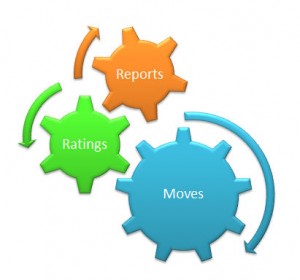From Pushing information to Partnering to Creating Conversations, prospect research has come a long way to uncover donors in your data.
Before the internet and before relational databases, the world had a different perspective on information. Gathering information, analyzing it and producing a thoughtful presentation that pulled all of the pieces together looked like books, white papers and other time-consuming and laborious efforts. Post internet and relational databases, it can still look like that. But now those books and white papers have a whole lot of other company in the form of shorter and/or more precise groupings of information, and often leave us, the users, to draw our own conclusions.
Pushing Information
 Before the world went digital, prospect research required visits to the library, combing through paper files and interviewing people in the organization. After this manual collection, the information was compiled into a profile. You might have gotten suggestions on how to cultivate and what gift to ask for from the prospect, and you might not have. Browsing newspapers and magazines for who’s who in the community was dominated by the front-line fundraisers.
Before the world went digital, prospect research required visits to the library, combing through paper files and interviewing people in the organization. After this manual collection, the information was compiled into a profile. You might have gotten suggestions on how to cultivate and what gift to ask for from the prospect, and you might not have. Browsing newspapers and magazines for who’s who in the community was dominated by the front-line fundraisers.
Now, the internet supplies us with extraordinary access to information in our town, state, country and in the world. With some prospects, the challenge is not finding information, but whittling down the information to what is most relevant and useful for fundraising. Relational databases give us the ability to store multiple levels of connecting information, such as all gifts made to a fund over a period of time or one individual’s gifts to a fund over a period of time. We can ask questions that our database can answer quickly and easily. Because of this, prospect researchers have moved out of the library and onto the computer.
Becoming Strategic Partners
 For many researchers, we have stopped pushing information and have begun partnering with our front-line fundraisers. We don’t create the same prospect profile for every request. We customize our research to answer the most common and most pressing questions. More and more we are being brought to places like the campaign planning table, where we present information about our donors to assist leadership in making decisions. Questions answered might include, “Do we have enough prospects with the capacity and affinity to make the leadership gifts we need to launch the campaign?” or “How many of our annual fund donors made their usual operating gift plus a gift to a special project when asked?”
For many researchers, we have stopped pushing information and have begun partnering with our front-line fundraisers. We don’t create the same prospect profile for every request. We customize our research to answer the most common and most pressing questions. More and more we are being brought to places like the campaign planning table, where we present information about our donors to assist leadership in making decisions. Questions answered might include, “Do we have enough prospects with the capacity and affinity to make the leadership gifts we need to launch the campaign?” or “How many of our annual fund donors made their usual operating gift plus a gift to a special project when asked?”
Prospect research has been providing reactive research such as profiles and proactive research such as filling prospect pipelines and maintaining relationship management systems. In many organizations, especially higher education and large hospitals, prospect research has become a strategic partner on the fundraising team. Prospect research ensures that front-line fundraisers have the prospects to visit and the information intelligence to solicit the largest and most appropriate gift.
The Explosion of Big Data
When you combine the storage and retrieval advances of relational databases with the internet, especially social platforms, you have an explosion of information – most often referred to as “big data”. Most people are aware of the results of harnessing the power of this much data, but few understand how it works and are capable of applying it to new situations. Results look like Amazon.com offering you suggestions on what others purchased with that book you were browsing or other popular titles in that section. It also looks like Google’s Flu Trends that helps specific hospitals predict patient volume during the flu season.
Creating Conversations With Data Analytics
 The future of prospect research is already here. Right now, organizations across the country are using new tools to answer complex questions and track complex trends. These new tools are visual and manage multiple file formats with the same ease with which Superman leaps tall buildings in a single bound. Your database might be clunky and difficult to get information out of, but as long as the data is consistent, these new tools make analysis and reporting pretty simple. Often using an online “community” setting, prospect researchers create projects and share them with other fundraising staff. In some cases, with a little training, those front-line fundraisers and other staff can tweak the results on their own.
The future of prospect research is already here. Right now, organizations across the country are using new tools to answer complex questions and track complex trends. These new tools are visual and manage multiple file formats with the same ease with which Superman leaps tall buildings in a single bound. Your database might be clunky and difficult to get information out of, but as long as the data is consistent, these new tools make analysis and reporting pretty simple. Often using an online “community” setting, prospect researchers create projects and share them with other fundraising staff. In some cases, with a little training, those front-line fundraisers and other staff can tweak the results on their own.
For example, using intuitive drag-and-drop technology, a prospect researcher can view information from the donor database from multiple perspectives. Let’s say the business school wants to send invitations to exclusive events around the country to raise funds for a new program. Our researcher might start with a quest to find business school alumni, within a certain graduating year span, who were members of a particular school club. She uploads that file to the project area. Next, she calls the business school fundraiser. On the call, the researcher and fundraiser discuss the project they can both view live on their desktops. They begin to “play” with the uploaded list.
- Can you show me who made gifts at $1,000+?
- Now who lives within 50 miles of the first location?
- Hmmm. Too small.
- Okay. What do the people who live within 50 miles look like? Wait! We limited the graduation years. Can we include all graduation years?
- Another file is uploaded to the project space with much broader information this time.
- What do the people who live within 50 miles look like? Gift size, graduation year, club participation, frequency of giving and whether they are assigned to a gift officer.
- The researcher creates a bar chart of giving frequency because she thinks there might be a pattern.
- Wow! It looks like club participants are frequent givers. What if we look at all frequent givers whose past 5-year total is over $5,000?
- The researcher clicks on the bar in the bar chart of most frequent givers and “pulls” it out. She then applies a filter for past 5-year total giving.
- Okay. That’s still too many. How many live within 50 miles?
- The researcher clicks on the new list and applies another filter.
- But I can’t invite anyone who is already assigned to a major gift solicitor.
- Another filter is applied.
- That’s a good number of people!
- The researcher saves that “report” so the fundraiser can pull it for the mailing and RSVP list. The unique constituent number is attached so that the invitation mailing and other activities can be recorded in the donor database.
- After the event, a new file is pulled into the project space so that the effort can be evaluated using the same techniques.
This was a simple example, but notice how the researcher was beginning to create conversations around the data? She could recognize certain trends and demonstrate them visually to the front-line fundraiser.
Do You Have Enough Data for Analytics?
 If you think that you don’t have enough “big data” for projects like this, I suggest you think it over. Most organizations collect more data than they view or use in any meaningful way. We have Facebook friends, Twitter followers and email campaigns. We have the data, but it’s like the junk drawer in your kitchen. It’s all a jumble and finding anything specific takes too much time. For example, lots of organizations of all sizes are still struggling with email campaigns. New email donors receive snail mail instead of email, or nothing at all. Especially for emerging organizations, all of these separate fundraising and stewardship/marketing efforts are often collecting data separately and they may or may not be able to access that data in any meaningful way.
If you think that you don’t have enough “big data” for projects like this, I suggest you think it over. Most organizations collect more data than they view or use in any meaningful way. We have Facebook friends, Twitter followers and email campaigns. We have the data, but it’s like the junk drawer in your kitchen. It’s all a jumble and finding anything specific takes too much time. For example, lots of organizations of all sizes are still struggling with email campaigns. New email donors receive snail mail instead of email, or nothing at all. Especially for emerging organizations, all of these separate fundraising and stewardship/marketing efforts are often collecting data separately and they may or may not be able to access that data in any meaningful way.
But if we could throw our jumble of data files into a “project”… we might learn thing like we have (a) donors who (b) like us on Facebook, (c) click on our videos more than other posts and (d) make higher online gifts than other online donors. That would be useful information, right? You might then want to learn which video topics generate a better response than other video topics. If you had no idea this was going on, you would continue to randomly post videos on whatever content, and maybe even platform, that felt good at the moment. Combining donor data with Facebook data yielded new insights that could change behavior leading to higher giving with less effort.
Is Analytics Really Out of Reach?
Even if you feel that these “sophisticated” techniques are out of your reach, either because of staff skill level or cost, I urge you to take a larger look at your fundraising program – just to be sure. Many of us lament that leadership does not see the value in investing in fundraising staff or donor acquisition. We wish they could go beyond counting existing dollars to see the magic of investing in a staff member who raises far more funds than her salary. I am inviting you to step out of your technology “counting” and see the magic of streamlining your fundraising efforts through the efficient use of data.
I’m not suggesting that you jump into “big data” collection and analysis – unless you really see value there. I’m suggesting that you consider how a combination of outsourcing and internal skill-building could lead to consistently improved results. What if you could…
- Put in place a routine appeal evaluation (snail mail, email, or social media) that showed you in numbers, and visually, how you performed this time and compared to other efforts.
- Know how much you could spend on donor acquisition and still make a great return on your investment based on knowledge of existing donors?
- Tightly track the behaviors that lead to consistent major gifts – whether that’s multi-year pledges to special projects or high-end yearly gifts?
And those examples don’t even touch social media, website performance or whether your stewardship program actually leads to loyal, increased giving.
You are Never Too Small, Too New, Too Anything, for Good Strategy
When you hire a prospect researcher, as a consultant or staff member, you can hire and train a strategic thinker who will help you streamline your fundraising, raising more money with lower costs. Prospect research has something of benefit for all organizations. Whether or not you join it, prospect research’s path in fundraising continues to move forward into new territory, leaving behind it a clear and certain trail of fundraising success!
Other Posts You Might Like
The Multi-Channel Fundraising Game
Facial Recognition Software and Donors
About Aspire Research Group LLC
Headquartered in Tampa Bay, Florida, Aspire Research Group was founded so that every development office could have the benefits of professional prospect research. Known for our creativity and clear communications, we work with organizations who are worried about finding their next big donor, concerned about what size gift to ask for, and frustrated that they aren’t meeting their major gift goals. Do you need to close more major gifts?
www.AspireResearchGroup.com 727 231 0516







